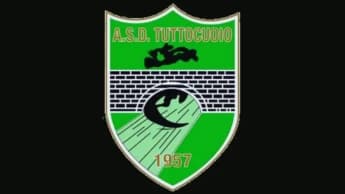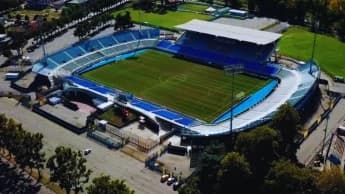Where history, passion, and the Adriatic Sea converge: The enduring legacy of Pescara’s iconic stadium.
Nestled in the vibrant heart of Pescara, within Italy’s picturesque Abruzzo region, the Stadio Adriatico – Giovanni Cornacchia stands as a monumental tribute to the city’s rich sporting heritage, architectural ingenuity, and communal spirit. Since its inauguration in 1955, this iconic venue has transcended its role as a mere sports arena, evolving into a symbol of resilience, pride, and cultural identity for the people of Pescara and beyond.
A Masterpiece of Architectural Vision
Designed by the renowned Italian architect Luigi Piccinato, the Stadio Adriatico emerged during a transformative era of post-war reconstruction. Drawing inspiration from Rome’s Stadio Olimpico, which opened just two years prior, Piccinato crafted a structure that seamlessly blended modernist aesthetics with functional versatility. The stadium’s defining feature—its elegant arches supporting the bleachers—echoes the grandeur of classical Roman architecture while embodying the optimism of mid-20th-century design.
Originally conceived as a multipurpose athletic facility, the stadium was envisioned as a hub for the Italian National Olympic Committee, capable of hosting a wide array of sports and events. Its strategic location in Pescara, a coastal city renowned for its stunning Adriatic Sea views and vibrant culture, further cemented its status as a focal point for athletic excellence and national unity.
A Living Chronicle of Sporting Glory
The Stadio Adriatico’s history is a tapestry of unforgettable moments, each thread woven with the passion of athletes and fans alike. Its journey began modestly, with single-level stands accommodating 10,000 spectators. However, the stadium’s trajectory changed dramatically in 1977, when Delfino Pescara 1936 achieved its historic promotion to Serie A, Italy’s top football division. To meet the demands of a growing fanbase, a second tier was added, expanding the capacity to 34,000 and transforming the venue into a fortress of football fervor.
The stadium’s international acclaim was solidified during the 1960 Summer Olympics, where it hosted preliminary football matches. This prestigious event not only placed Pescara on the global sporting map but also showcased the region’s hospitality and state-of-the-art facilities to a worldwide audience. Decades later, the stadium’s role as a reserve venue for the 1990 FIFA World Cup further underscored its significance in Italy’s football landscape.
In 2009, the Stadio Adriatico underwent a comprehensive €15 million renovation in preparation for the Mediterranean Games. The upgrades included laminated wood coverings for the bleachers, air-conditioned suites, a modernized press box, and enhanced accessibility features. These improvements not only elevated the spectator experience but also reduced the stadium’s capacity to 24,400 seats, aligning with contemporary safety standards.
On October 22, 2009, the stadium was renamed in honor of Giovanni Cornacchia, a native of Pescara and an Olympic hurdler who represented Italy in three consecutive Summer Olympics. This renaming was a poignant tribute to local athletic achievement, further strengthening the bond between the stadium and the community it serves.
Architectural Brilliance Meets Coastal Charm
The Stadio Adriatico’s design is a harmonious blend of form and function. Its oval-shaped structure, supported by rhythmic arches, creates a visually striking silhouette that has become synonymous with Pescara’s skyline. The use of reinforced concrete and local stone reflects the architectural sensibilities of post-war Italy, emphasizing durability and simplicity.
The stadium’s interior is equally impressive, with steeply graded seating ensuring unobstructed views of the action, despite the presence of an athletics track. The 2009 renovations introduced laminated wood coverings over the bleachers, adding a touch of warmth to the otherwise concrete-dominated aesthetic. The integration of energy-efficient systems and green spaces around the venue further highlights the stadium’s commitment to sustainability.
One of the most captivating aspects of the Stadio Adriatico is its proximity to the Adriatic Sea. The panoramic views of the coastline create a breathtaking backdrop, enhancing the spectator experience and infusing the venue with a unique sense of place. Whether bathed in sunlight or illuminated under floodlights, the stadium’s architectural grace and natural beauty leave an indelible impression on all who visit.
The Heartbeat of Pescara’s Community
Beyond its architectural and sporting significance, the Stadio Adriatico is a cultural landmark that embodies the spirit of Pescara. On match days, the streets surrounding the stadium come alive with the buzz of passionate fans, vendors selling team memorabilia, and the aroma of local street food. The Curva Nord, home to Pescara’s most ardent ultras, is the epicenter of the electric atmosphere, with chants, songs, and synchronized flag-waving creating an unforgettable spectacle.
The stadium’s versatility extends beyond football, hosting athletics competitions, concerts, and cultural events that bring together people of all ages and backgrounds. These gatherings not only celebrate the city’s rich traditions but also foster a sense of unity and pride among residents.
A Legacy of Resilience and Renewal
The Stadio Adriatico – Giovanni Cornacchia is more than just a venue; it is a living testament to the enduring power of sport to inspire, unite, and uplift. From its Olympic beginnings to its role as the home of Delfino Pescara 1936, the stadium has witnessed countless moments of triumph, heartbreak, and celebration.
As it looks toward the future, the Stadio Adriatico remains a beacon of hope and aspiration for Pescara. Its ability to adapt to changing times while preserving its historical essence is a testament to the resilience and ingenuity of the community it serves. With every roar of the crowd and every victory celebrated on its hallowed ground, the stadium continues to write new chapters in the rich history of this remarkable Italian city.
In Summary:
The Stadio Adriatico – Giovanni Cornacchia is not just a stadium; it is a symbol of Pescara’s past, present, and future. Its architectural brilliance, sporting legacy, and cultural significance make it a cherished landmark that resonates with locals and visitors alike. As it stands proudly by the Adriatic Sea, the stadium remains a testament to the enduring spirit of sport and community, inspiring generations to come.





